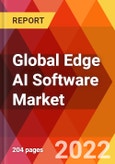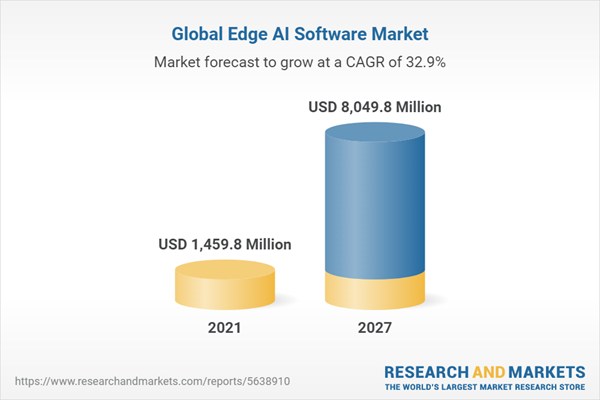The global edge AI software market held a market value of USD 1,459.8 Million in 2021 and is projected to reach USD 8,049.8 Million by the year 2027. The market is anticipated to register a CAGR of 35.9% during the forecast period.
Edge AI is the disposition of artificial intelligence applications in devices all over the physical world. The AI computation has to be done near the user at the edge of the network, near to the location of the data, rather than centrally in a cloud computing facility or even a private data center.
The market is set to boom at a double-digit growth rate owing to the increased advancements in AI-powered IoT in smart applications. The increased use of edge AI software in the 5G network industry also fuels the growth rate of the market.
On the other hand, the data privacy compliance standards are not proper in all regions which hamper the market growth to a limited extent. Moreover, AI and machine learning continue to develop, yet many AI disruptors lack the capacity to process complex AI, machine learning algorithms. Thus, such elements hinder the market growth.
The extensive implementation of the Internet of Things has powered the detonation of big data. With the swift ability to amass data in every aspect of a business, the edge AI software are playing a prominent role. The AI-powered IoT software are used from industrial sensors, robots, to smart cameras. Thus, the increasing advancements fuel the market growth.
The edge AI software aids numerous end use industries. Using such a top-notch software for 5G networking purposes decreased costs and provides faster insights. It also offers effective data control and a streamlined operation. The 5G network permits establishing data centers at edge modules, and implementing industry-specific networks aided by virtualization and software-defined networking principles in a single environment. 5G coupled with IoT offers stable and secured connectivity, which increases the preference rate of this market considerably.
The global edge AI software market is segmented into component, data source, application, and end users.
By region, the global edge AI software market is divided into North America, Europe, Asia Pacific, Middle East & Africa, and South America.
The Asia-Pacific market for edge AI software held the largest market share of more than 35% in 2021 owing to the more technological developments in the area. Moreover, the market in other regions of North America, APAC, and Middle East and Africa are anticipated to grow at a considerable rate.
Key players operating in the global edge AI software market include Anagog Ltd., Alef Edge, Inc., AWS, Bragi.Com, Azion Technologies, Chaos Prime, Inc., Foghorn Systems, Inc., Clearblade, Inc., Google, IBM, Gorilla Technology Group, Inc., Imagimob, TACT.AI, Nutanix, Microsoft, Sixsq Sarl, Synaptics, Octonion, TIBCO Software, and Veea Inc, among others.
The key four players in the market hold approximately 25% to 30% of the market share. These market players are capitalizing in collaborations, product launches, mergers, acquisitions, and expansions to sustain a competitive edge in the market. For instance, in August 2021, Alef Edge launched Private Edge, the first platform that will make the edge internet a reality. Alef’s Private Edge platform is a software-defined, mobile edge-based neutral host and open approach that aids enterprises to build and operate their own customized virtual private network.
Edge AI is the disposition of artificial intelligence applications in devices all over the physical world. The AI computation has to be done near the user at the edge of the network, near to the location of the data, rather than centrally in a cloud computing facility or even a private data center.
The market is set to boom at a double-digit growth rate owing to the increased advancements in AI-powered IoT in smart applications. The increased use of edge AI software in the 5G network industry also fuels the growth rate of the market.
On the other hand, the data privacy compliance standards are not proper in all regions which hamper the market growth to a limited extent. Moreover, AI and machine learning continue to develop, yet many AI disruptors lack the capacity to process complex AI, machine learning algorithms. Thus, such elements hinder the market growth.
Growth Influencers:
Advancements in AI-powered IoT (Internet of Things) for Intelligent Systems and Smart Applications
The extensive implementation of the Internet of Things has powered the detonation of big data. With the swift ability to amass data in every aspect of a business, the edge AI software are playing a prominent role. The AI-powered IoT software are used from industrial sensors, robots, to smart cameras. Thus, the increasing advancements fuel the market growth.
Use of Edge AI computing in 5G network
The edge AI software aids numerous end use industries. Using such a top-notch software for 5G networking purposes decreased costs and provides faster insights. It also offers effective data control and a streamlined operation. The 5G network permits establishing data centers at edge modules, and implementing industry-specific networks aided by virtualization and software-defined networking principles in a single environment. 5G coupled with IoT offers stable and secured connectivity, which increases the preference rate of this market considerably.
Segments Overview:
The global edge AI software market is segmented into component, data source, application, and end users.
By Component
- Software
- Software Tools
- Platform
- Services
- Training and Consulting Services
- System Integration and Testing
- Support and Maintenance
By Data Source
- Biometric Data
- Mobile Data
- Sensor Data
- Speech Recognition
- Video and Image Recognition
By Application
- Access Control
- Autonomous Vehicles
- Energy Management
- Predictive Maintenance
- Remote Monitoring
- Telemetry
- Video Surveillance
- Others
By End Users
- Advanced Industries
- Banking and Insurance
- Chemicals and Agriculture
- Consumer
- Cross-Vertical
- Energy and Materials
- Healthcare
- Infrastructure
- Media and Entertainment
- Public Sector and Utilities
- Retail
- Travel, Transport and Logistics
Regional Overview
By region, the global edge AI software market is divided into North America, Europe, Asia Pacific, Middle East & Africa, and South America.
The Asia-Pacific market for edge AI software held the largest market share of more than 35% in 2021 owing to the more technological developments in the area. Moreover, the market in other regions of North America, APAC, and Middle East and Africa are anticipated to grow at a considerable rate.
Competitive Landscape
Key players operating in the global edge AI software market include Anagog Ltd., Alef Edge, Inc., AWS, Bragi.Com, Azion Technologies, Chaos Prime, Inc., Foghorn Systems, Inc., Clearblade, Inc., Google, IBM, Gorilla Technology Group, Inc., Imagimob, TACT.AI, Nutanix, Microsoft, Sixsq Sarl, Synaptics, Octonion, TIBCO Software, and Veea Inc, among others.
The key four players in the market hold approximately 25% to 30% of the market share. These market players are capitalizing in collaborations, product launches, mergers, acquisitions, and expansions to sustain a competitive edge in the market. For instance, in August 2021, Alef Edge launched Private Edge, the first platform that will make the edge internet a reality. Alef’s Private Edge platform is a software-defined, mobile edge-based neutral host and open approach that aids enterprises to build and operate their own customized virtual private network.
The global edge AI software market report provides insights on the below pointers:
- Market Penetration: Provides comprehensive information on the market offered by the prominent players
- Market Development: The report offers detailed information about lucrative emerging markets and analyzes penetration across mature segments of the markets
- Market Diversification: Provides in-depth information about untapped geographies, recent developments, and investments
- Competitive Landscape Assessment: Mergers & acquisitions, certifications, product launches in the global edge AI software market have been provided in this research report. In addition, the report also emphasizes the SWOT analysis of the leading players.
- Product Development & Innovation: The report provides intelligent insights on future technologies, R&D activities, and breakthrough product developments
- Pricing Analysis: Pricing analysis of various metals and other components used in the manufacturing
- Manufacturing Cost Analysis: Cost-share of various components in edge AI software
- Investment by Key Players
- IBM
- Microsoft
- Apple
- Regulatory Landscape
- The Personal Information Protection and Electronic Documents Act (PIPEDA)
- General Data Protection Regulation
- European Committee for Standardization
- Personal Data Protection Act
- Cloud Computing Framework
The global edge AI software market report answers questions such as:
- What is the market size and forecast of the global edge AI software market?
- What are the inhibiting factors and impact of COVID-19 on the global edge AI software market during the assessment period?
- Which are the products/segments/areas to invest in over the assessment period in the global edge AI software market?
- What is the competitive strategic window for opportunities in the global edge AI software market?
- What are the technology trends and regulatory frameworks in the global edge AI software market?
- What is the market share of the leading players in the global edge AI software market?
- What modes and strategic moves are considered favorable for entering the global edge AI software market?
Table of Contents
Chapter 1. Research Framework
Chapter 2. Research Methodology
Chapter 4. Global Edge AI Software Market Overview
Chapter 5. Global Edge AI Software Market Analysis, By Component
Chapter 6. Global Edge AI Software Market Analysis, By Data Source
Chapter 7. Global Edge AI Software Market Analysis, By Application
Chapter 8. Global Edge AI Software Market Analysis, By End Users
Chapter 9. Global Edge AI Software Market Analysis, By Region/ Country
Chapter 10. North America Edge AI Software Market Analysis
Chapter 11. Europe Edge AI Software Market Analysis
Chapter 12. Asia Pacific Edge AI Software Market Analysis
Chapter 13. Middle East & Africa Edge AI Software Market Analysis
Chapter 14. South America Edge AI Software Market Analysis
Chapter 15. Company Profile (Company Overview, Financial Matrix, Key Product landscape, Key Personnel, Key Competitors, Contact Address, and Business Strategy Outlook)
Companies Mentioned (Partial List)
A selection of companies mentioned in this report includes, but is not limited to:
- Anagog Ltd.
- Alef Edge, Inc.
- AWS, Bragi.Com
- Azion Technologies
- Chaos Prime, Inc.
- Foghorn Systems, Inc.
- Clearblade, Inc.
- IBM
- Gorilla Technology Group, Inc.
- Imagimob
- TACT.AI
- Nutanix
- Microsoft
- Sixsq Sarl
- Synaptics
- Octonion
- TIBCO Software
- Veea Inc
Table Information
| Report Attribute | Details |
|---|---|
| No. of Pages | 204 |
| Published | July 2022 |
| Forecast Period | 2021 - 2027 |
| Estimated Market Value ( USD | $ 1459.8 Million |
| Forecasted Market Value ( USD | $ 8049.8 Million |
| Compound Annual Growth Rate | 32.9% |
| Regions Covered | Global |









